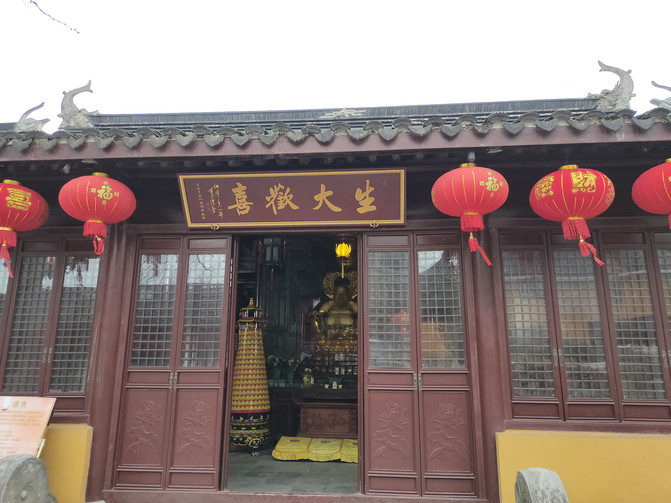Yonghui Zen Temple, Shibi Wo on the bank of Taihu Lake
★ Tourist location: Suzhou Shibi
Shibi belongs to Guangfu Scenic Area and is located on the top of Panchi Mountain, also known as Shibi Wo. In fact, we didn't know about this attraction before. We just accidentally discovered that there was such a place on the edge of Taihu Lake. Anyway, there was still some time left to find a way.
The car was getting more and more desolate, and we almost wondered if there was a navigation problem. Fortunately, it was not a long journey and I finally saw Taihu Lake. We found a place to park the car. There is no special parking lot here. If a car is parked on the roadside, we also parked behind it. There is Taihu Lake on one side and hills on the other. There are many such scenery around Taihu Lake.
Walking up the steps, there is a Chengxin Pavilion on the roadside, with square stone pillars and single eaves, a white wall on the back, and a stone in the middle, which may be Taihu Lake Stone.
Continue to climb up to the top of Panchi Mountain, which is Yonghui Zen Temple, also known as Shibi Jingshe and Shibi Temple, covering an area of only more than three acres. However, it is very quiet and peaceful to build a room next to the mountain.
The plaque at the mountain gate reads "Happy Life", and I always feel happy to see the smiling Maitreya. The four great kings on both sides do not have statues, but use portraits. Wei Tuo Bodhisattva is a statue and is not covered with glass.
Behind it is the "Buddha Day Grows Glory", which should be the Daxiong Hall, where Sakyamuni Buddha is enshrined, with Kasyapa and Ananda on both sides. Manjusri and Pushri are both golden statues. Without the iconic white elephant and green lion, it always feels like something is missing.
Behind him is the statue of Guanyin, and behind him is his avatar. It is said that there are thirty-three incarnations of Guanyin, including Yangzhi Guanyin, Longtou Guanyin, Holding Sutra Guanyin, Round Light Guanyin, Game Guanyin, Baiyi Guanyin, Lianwu Guanyin, Longjian Guanyin, Medicinal Guanyin, Yuanyuanyin, Yuanyuanyin, Dewang Guanyin, Shuiyue Guanyin, Yiye Guanyin, Qingneck Guanyin, Weide Guanyin, Extended Life Guanyin, Six-Season Guanyin, Zhongbao Guanyin, Yanhu Guanyin, Nengjing Guanyin, Anu Guanyin, Yeyi Guanyin, Glazed Guanyin, Clam Guanyin, Puci Guanyin, Guanyin Guanyin, Tongzhang Guanyin, etane Guanyin, like Guanyin, Buer Guanyin, Lotus Guanyin, Sprinkling Guanyin, Dorozun Guanyin, Amomati Guanyin, Malangfu Guanyin. We commonly see Yangzhi Guanyin, White-clothed Guanyin, and Sprinkling Guanyin. We made a rough count, and it seems that there are more than thirty-three?
The Thousand-Hand Guanyin is enshrined in the Hall of Great Compassion. Two identical Bodhisattva stands back to back on the lotus platform, with one pair of hands closed, one pair of hands placed on the abdomen, the other hands each holding a magic implement, and some hands are more pictographic.
The construction of Yinlu has some characteristics. Half of the mountains were borrowed to make walls, and a statue of Guanyin was carved on the rock mass. It sat on a lotus platform with one hand on his chest and the other on his lap.
The gate, Tianwang Hall, and Daxiong Hall were built in the third year of Jiajing Longqing in the Ming Dynasty. They turned out to be the place where Master Hanshan built his grass. It was later destroyed and rebuilt during the Daoguang period. Hanshan, also known as Deqing, was born in Quanjiao, Anhui Province. During the Wanli period, he presided over the Praying Prayer for Empress Dowager Li in Wang Taishan. The temple used to be the ashram of Linji Sect, one of the five sects and two sects of Zen and now belongs to the Pure Land Sect. It is said that all the masters in the temple come from Lingyanshan Buddhist College.
Beside the hall are rocks and rocks, with many cliff stone carvings, all of which are the travel notes of famous officials, scholars and literati from past dynasties. The area of this stone rock is not too large, but the mokes are very dense. Looking at the evening sky, we didn't take a closer look at them. Most of them were cliffs from the Qing Dynasty.
There is a heather tree behind the mountain, which grew in the cracks in the rocks during the Yuan Dynasty. It looks like a black dragon lying down, like a giant python circling and rising to the top of the cliff, so it is also known as the sleeping dragon.
Standing on the mountain, you can overlook Taihu Lake. Whenever we talk about Taihu Lake, we call it Wuxi Taihu Lake. In fact, Suzhou accounts for 70% of Taihu Lake. Taihu Lake in Suzhou is relatively quieter. For example, there are basically no tourists here. From beginning to end, we only saw another group of two people.
At the foot of the mountain is the tomb of Jiang Hanting. Jiang Hanting is named Shangyu, the word Hanting, and the name Hanting Jushi. He is a modern painter in Yushan Town, Changshu. He was a member of the Second and Third CPPCC sessions of Shanghai City. He died in Shanghai in 1963 at the age of 60. He painted "Hundred Flowers Collection" and "Hundred Beasts Painting". In 1060, at the invitation of Premier Zhou Enlai, he painted a huge "Red Plum Painting" for the Great Hall of the People.
Next to it is Jiang Shenghua's tomb. She is Jiang Hansa's daughter. She has studied painting with her father since she was a child. She has served as a painter of the Shanghai Arts and Crafts Factory and a painter of the Shanghai City Chinese Academy of Painting. Her works mostly express the beauty of still life and scenery.














































Previous Article:Songgang Kepantian Street meets all your expectations
Next Article:Shajiabang in winter, fading away the bustling emptiness
